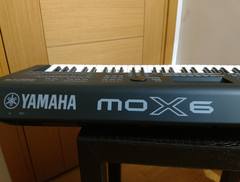-
Posts
9,573 -
Joined
Awards
This user doesn't have any awards
System
-
CPU
AMD 5600X
-
Motherboard
Asus B550-E
-
RAM
32GB DDR4
-
GPU
RTX 3080 10G
-
Case
Lian-Li O11 Dynamic
-
Storage
500GB boot SSD + 2TB storage SSD
-
PSU
Corsair RMx 850
-
Display(s)
LG C2 42"
-
Cooling
Custom water cooling
Fans: Noctua NF-A12x25 -
Keyboard
Logitech G915 TKL
-
Mouse
Logitech G Pro wireless
-
Sound
DAC/AMP: FiiO K5 Pro
Headphones: Beyerdynamic Amiron Home
Micophone: Antlion ModMic -
Operating System
Windows 11 Pro
Recent Profile Visitors
9,349 profile views
Stahlmann's Achievements
-
Weird. I don't notice any difference when using it in desktop applications, which is why I left it turned on for months. I'm beginning to think I find it underwhelming (putting it lightly) because maybe it isn't working at all.
-
In my experience, both Dolby Atmos and Windows Sonic don't really do anything. Not in games and not in movies. For reference I'm using the Beyerdynamic Amiron Home, an open backed headphone. What is an important spec to look for in headphones to get more out of virtual surround? What has your experience been like?
-

who actually reads the posting guide lines.
Stahlmann replied to Phantasmagoria's topic in Off Topic
In most forums it basically comes down to "don't be a dick", "no shitposting" and "no advertising". The Tech News subforum is a bit stricter, but it makes sense. -
I edited my previous post. The models I mentioned are basically the go-to monitors under £1000. You don't get significant upgrades by buying closer to your maximum budget. The next significant uprade would be 32" 4K 240hz, but these start around £1250.
-
It's the way Windows handles multiple monitors from left to right. If you run your game at a lower resolution in full screen, the left desktop gets smaller and everything moves to the left. The only real and permanent way to fix this is to have the 2nd monitor on the left. I know it sounds stupid, but I have the same problem. You can also just set it to the left in software and get used to the unintuitive cursor movement between your monitors. I also remember NOT having this issue in the past, and I think the common denominator is that I used Windows 10 before and now on 11 I have this issue.
-
4K models are out of your price range, except the last-gen 42" and 48" models. If you want to stick with regular monitor sizes, you still have the choice between 27" 1440p 240Hz and 34" 1440p 175Hz ultrawide models. What's more important to you, ultrawide or higher refresh rate? It basically comes down to these two models: Alienware AW3423DWF 34.2" 3440 x 1440 165 Hz Curved Monitor (AW3423DWF) - PCPartPicker Asus ROG Swift OLED PG27AQDM 26.5" 2560 x 1440 240 Hz Monitor (90LM08Q0-B01AB0) - PCPartPicker Dell Alienware AW3423DWF vs ASUS ROG Swift OLED PG27AQDM Side-by-Side Monitor Comparison - RTINGS.com
-
TL;DR: Test it for yourself. But try to stay unbiased. If you have any chance of doing blind tests, like letting someone else change the refresh rate, then trying it out to see if you can tell. Or do one of these aim training maps at different refresh rates in CS2 to see if you can actually score higher. There are plenty of tests you can run to see if you get something out of 240hz before the return window closes. Maybe you will also just turn the monitor on, immediately tell the difference and just be happy with it.
-
It's different for every person. As strange as it sounds there are people who can't even tell the difference between 60Hz and 144Hz. But there are basically 3 aspects that change with the refresh rate, all of which have been tested by YouTubers and reviewers: Blind tests done by JayzTwoCents showed they could all reliably tell the difference between 60 and 120, but between 120 and 240 they were just guessing. They were basically only looking at motion smoothness though. In terms of input lag, LTT measured a very noticeable upgrade in player performance from 60 to 144, but not a big upgrade to 240. So to get a big advantage out of 240 Hz you will need the skill to back it up. The monitor won't magically make you better. More casual players like Pauls Hardware couldn't get much out of 240Hz, but Shroud certainly could. In terms of motion clarity, the monitor in question needs the response times to back the refresh rate up. For example an OLED using 240Hz is roughly comparable to slower LCDs that run 360Hz. A 360Hz OLED is roughly comparable to slower LCDs running 540Hz and so on.
-
If the response times are a tad too slow, you won't get better motion clarity. You still get the lower input lag coming from a higher refresh rate though.
-
You probably won't notice much of a difference when you upgrade. With these things, you usually notice the difference after you get used to it and then downgrade again. I went from 144Hz to 240Hz and it wasn't that big of a difference. Then again, I don't play competitive games anymore. After trying the 240Hz monitor for a few days, I changed my mind and went with a 120Hz OLED, and for my personal use, the slower refresh rate doesn't make much of a difference. However, the better picture quality and HDR definitely do make a difference. In the end, the types of games you play are the most important factor in how much you can get out of higher refresh rates. Can you reliably hit >200 FPS in the games you play? If yes, then it can make a lot of sense.
-

DLSS Not Working on Linux. NVIDIA Drivers installed
Stahlmann replied to TheRealBlarp's topic in PC Gaming
No, DLSS is not better than FSR in all cases. But even if it performs slightly worse on the same quality preset, the image quality and especially the image stability (meaning in terms of flickering, shimmering, aliasing, etc.) is still superior to FSR in almost all situations, especially at lower target resolutions like 1080p and 1440p. The difference isn't as big at 4K, but it's still there. I don't have any personal experience with Final Fantasy 14, so I don't know how a difference of 756 points translates into FPS. The difference is about 7%, so if that translates into 7% better FPS, I wouldn't call DLSS "utter trash" because of such a small difference. -

DLSS Not Working on Linux. NVIDIA Drivers installed
Stahlmann replied to TheRealBlarp's topic in PC Gaming
DLSS is just as useful on low-end cards as it is on high-end cards. I think you're confusing DLSS with ray tracing, and I agree. Ray tracing performance will be so bad on a 3050 that I probably wouldn't even call it a feature. -

VPNs are basically useless as confirmed through testing.
Stahlmann replied to ChitterCharmer's topic in Tech News
Despite what most VPNs promise, even basic things like bypassing geo-blocks don't work most of the time. Netflix, for example, knows it's going through a VPN and will simply stop working until you turn it off. Since I don't sail the seven seas or buy weapons-grade uranium on a daily basis, and I don't use public WiFi, I don't see much use for one anyway. Funny how this is still the #1 marketing point every VPN makes. Isn't that basically just false advertising, and if it is, why doesn't anyone crack down on it? -
For around $300, I'd recommend the AOC Q27G3XMN. It's a bit slower than comparable IPS models, but it has a 336-zone backlight and VA-typical deep blacks, plus plenty of brightness, which results in a good HDR experience. HDR is probably the biggest single upgrade you can make from a regular 1080p IPS gaming monitor. If HDR isn't as important to you and you don't want a VA monitor, which is known to have poorer response times in darker scenes, the LG 27GP850-B is another great all-rounder that performs well in everything but HDR. Typically, I don't recommend spending much more than $350 on a 1440p monitor because you don't get much out of the extra money spent until you hit the $600-700 range where OLED models become available, which are the next big upgrade over LCD monitors in general. It's also worth taking a look at this video with recommendations for every budget:
-
What you're referring to is the inherent sample and hold stutter of low frame rate content on a display with very fast pixel response times, such as an OLED monitor. TVs typically use motion interpolation to make content appear smoother, but you don't get that with monitors because it adds another 50-100ms of input lag, which is not desirable on a monitor. You probably didn't notice this as much in the past because your earlier monitors had slower pixel response times, which made the picture a little blurrier and therefore did a better job of hiding this low frame rate stuttering. There are some video players that allow software interpolation, but I don't have any personal experience of this.




















